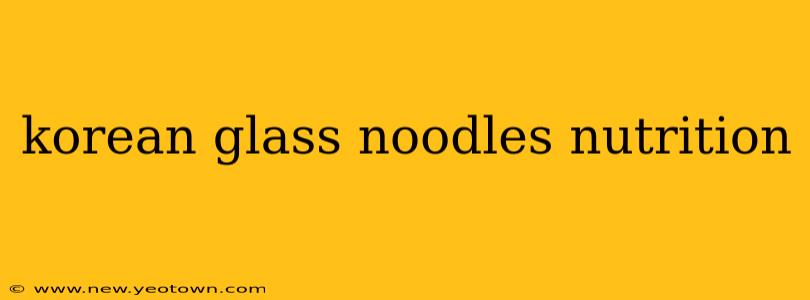Korean glass noodles, also known as dangmyeon (당면), are a popular ingredient in many Korean dishes. Their delicate texture and subtle flavor make them a versatile addition to soups, stir-fries, and salads. But beyond their culinary appeal, these translucent noodles offer a surprisingly interesting nutritional profile. Let's delve into the world of Korean glass noodles, uncovering their nutritional benefits and answering some common questions.
What are Korean Glass Noodles Made Of?
Korean glass noodles are primarily made from sweet potato starch. This gives them their characteristic translucency and chewy texture. Unlike wheat-based noodles, they are naturally gluten-free, making them a suitable option for those with celiac disease or gluten sensitivities. This simple ingredient list contributes to their relatively low calorie count.
Are Korean Glass Noodles Healthy?
The healthfulness of any food depends on the context of its place in a balanced diet. Korean glass noodles themselves aren't packed with vitamins and minerals like some vegetables, but they offer some advantages:
- Low in Calories: Compared to many other noodle varieties, Korean glass noodles are relatively low in calories, making them a good choice for those watching their weight.
- Gluten-Free: As mentioned, their sweet potato starch base makes them naturally gluten-free.
- Source of Carbohydrates: They provide carbohydrates, which serve as the body's primary energy source.
- Versatile Ingredient: Their neutral flavor allows them to absorb the flavors of other ingredients in a dish, making them a healthy canvas for adding vegetables and lean protein.
However, it's important to note that the nutritional value can be significantly impacted by how the dish is prepared. Deep-frying or adding excessive amounts of oil or sugar can negate the potential health benefits.
What is the Nutritional Information of Korean Glass Noodles?
A typical serving (about 100 grams) of dry Korean glass noodles contains approximately:
- Calories: Around 350-380 calories (this can vary slightly depending on the brand)
- Carbohydrates: The majority of the calories come from carbohydrates.
- Protein: Relatively low in protein.
- Fat: Very low in fat.
- Fiber: Relatively low in fiber.
It's important to consult the nutritional label of the specific brand you are using for the most accurate information.
How Many Calories are in Korean Glass Noodles?
As mentioned above, a typical 100g serving of dried glass noodles contains approximately 350-380 calories. Keep in mind that the calorie count will increase if you add sauces, oils, or other ingredients during cooking.
Are Korean Glass Noodles Good for Weight Loss?
Korean glass noodles can be part of a weight-loss diet, but only when incorporated mindfully. Their low calorie count is an advantage, but it's crucial to be aware of portion sizes and the addition of other ingredients. Pairing them with plenty of vegetables and lean protein in a balanced meal can contribute to a healthy weight management strategy.
Do Korean Glass Noodles Have Any Vitamins or Minerals?
While not a significant source of vitamins and minerals, Korean glass noodles do contain trace amounts of certain nutrients depending on the processing and potential addition of enriching ingredients during manufacturing. However, relying on glass noodles as your primary source of these nutrients is not recommended. A diverse diet rich in fruits, vegetables, and other whole foods is essential for optimal health.
Conclusion: A Delicious and Versatile Addition to a Balanced Diet
Korean glass noodles offer a delightful and versatile addition to a healthy diet. Their gluten-free nature, low calorie count, and neutral flavor make them a great option for a wide range of culinary creations. However, remember to be mindful of portion sizes and the addition of other ingredients to maximize their nutritional benefits and fit them seamlessly into your balanced eating plan. Enjoy experimenting with this versatile noodle in your favorite Korean dishes!

